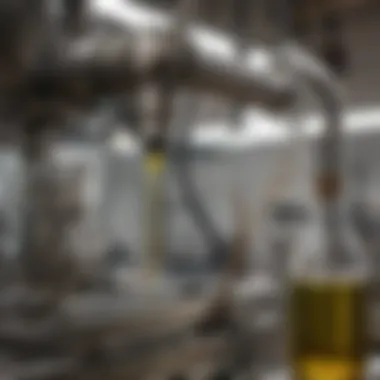Refining Olive Oil: A Comprehensive Exploration


Intro
The intricate process of refining olive oil holds many implications for culinary applications and nutritional qualities. Understanding this multifaceted method is crucial for both food enthusiasts and culinary professionals. By exploring the various refinement techniques, extraction methods, and different types of olive oil, one can gain a deeper appreciation of this popular ingredient.
The balance between flavor and purity is often what distinguishes high-quality olive oil from its lesser counterparts. Moreover, the market dynamics surrounding olive oil production are significant. They affect everything from availability to price, which in turn influences consumption patterns worldwide. This guide provides clarity on these essential components, ensuring that readers are well-informed about the qualities of olive oil they choose for their culinary needs.
Understanding Olive Oil
Understanding olive oil is essential for both culinary enthusiasts and those involved in the food industry. Olive oil is not just a cooking fat; it is a complex ingredient with a rich history, diverse types, and various health benefits. Recognizing its importance allows for better cooking choices and an appreciation of its unique characteristics.
History and Origin
Olive oil has been produced for thousands of years. Its origins trace back to the eastern Mediterranean Basin, particularly in ancient civilizations such as the Greeks, Romans, and Egyptians. Archeological evidence suggests that olive oil was being extracted as early as 6000 BC. It played a significant role in these cultures, not only in cuisine but also in religious rituals and medicine.
The cultivation of olive trees spread as trade routes expanded, reaching Spain, Italy, and even parts of the Americas. Each region developed its methods and traditions, contributing to the rich heritage of olive oil production today. This long-standing history underscores its value in global cuisine and culture.
Types of Olive Oils
Understanding the various types of olive oils is paramount in appreciating their distinct characteristics and uses in cooking. Here is an overview of the main types:
Extra Virgin Olive Oil
Extra Virgin Olive Oil is the highest quality. It comes from the first pressing of olives. This oil is known for its rich flavor and strong aroma. It contains no more than 0.8% acidity, making it a top choice for health-conscious consumers. Its high level of antioxidants and healthy fats contribute to numerous health benefits.
The superiority of extra virgin olive oil lies in its raw processing methods. It is typically cold-pressed, which means it undergoes minimal heating. This preservation of nutrients enhances its flavor and overall quality. However, extra virgin olive oil is best used in dressings or drizzling on dishes rather than for frying due to its low smoke point.
Virgin Olive Oil
Virgin Olive Oil is also made from the first pressing but has a slightly higher acidity level, up to 2%. It is still considered a good quality oil but often lacks the richness of extra virgin olive oil. Its flavor is milder, making it a versatile choice for various cooking applications. While it is a favorable option, it generally does not offer the same health benefits as its extra virgin counterpart.
Refined Olive Oil
Refined Olive Oil undergoes a treatment process that removes imperfections and acidity. This results in a neutral flavor, making it suitable for high-heat cooking, such as frying. It is less expensive than extra virgin or virgin olive oil. However, refining may strip some of its natural flavors and health properties, making it a less appealing option for those seeking quality.
Pomace Olive Oil
Pomace Olive Oil is produced from the leftover pulp, seeds, and skin of olives after the first pressings. It is extracted using solvents, which makes it a more cost-effective option for manufacturers. While it is suitable for cooking, it lacks the flavor and health benefits found in higher-quality oils. As such, its use is often limited to commercial food preparation rather than fine dining.
Understanding these different types of olive oil is crucial for users who want to enhance their culinary experiences and maintain health at the same time.
The Refining Process
The process of refining olive oil plays a vital role in determining the quality and characteristics of the final product. This phase not only influences flavor but also affects nutritional aspects and the oil’s stability during cooking. The refinment methods used can impact the overall perception of olive oil from both a culinary and health perspective. Understanding the various techniques involved in refining helps consumers identify high-quality products and appreciate the craftsmanship behind olive oil production.
Extraction Methods
Extraction methods are foundational steps in obtaining olive oil from olives. They directly affect the oil's yield, flavor, and nutritional value. There are three primary methods of extraction: cold pressing, hot extraction, and solvent extraction.
Cold Pressing
Cold pressing is a widely respected method in the olive oil industry. In this process, olives are crushed at temperatures below 27 degrees Celsius. This lower temperature helps preserve the oil's flavor, aroma, and nutritional properties.
A key characteristic of cold pressing is that it maintains the integrity of the oil, resulting in a higher concentration of antioxidants and polyphenols. These compounds contribute to the health benefits associated with olive oil, making this method a popular choice for those seeking the highest quality product. The unique feature of cold pressing is that it does not involve heat or chemicals in the extraction, ensuring a pure product.
However, one of the disadvantages is the lower oil yield compared to hot extraction and solvent methods. Consequently, cold-pressed oils tend to be more expensive.
Hot Extraction
Hot extraction involves applying heat during the oil production process. This method can increase the yield from the olives, making it more economical for producers. The characteristic feature of hot extraction is the use of heat to facilitate oil release, which can result in a smoother, milder flavor compared to cold-pressed oils.
The unique aspect of hot extraction is that it can enhance efficiency in large-scale production. However, it often compromises certain nutritional qualities, such as polyphenol levels, and can lead to a less complex flavor profile. Consumers who prioritize flavor and health benefits may find this method less appealing.


Solvent Extraction
Solvent extraction is a method that utilizes chemical solvents, typically hexane, to extract oil from olives. This technique is generally employed to maximize oil yield, especially in lower-quality oils. The key characteristic of solvent extraction is its efficiency, given the high amount of oil extracted from the raw material.
One unique feature of this method is that it allows for the production of refined oils that can be relatively inexpensive. However, there are significant disadvantages. The use of solvents raises concerns over chemical residues and can also strip the oil of flavor and beneficial compounds. As a result, consumers who are conscious about purity and quality may view solvent-extracted oils with skepticism.
Purification Techniques
Purification is crucial for enhancing oil quality as it removes unwanted impurities and helps stabilize the product. Different techniques are employed to achieve this goal, including filtering, decanting, and centrifugation.
Filtering
Filtering is a common technique used to clarify olive oil by removing solid particles. This process contributes to the visual appeal of the oil and improves its shelf life by reducing the risk of microbial growth. The primary characteristic of filtering is that it enhances the clarity while maintaining the oil's flavor profile.
A unique aspect of filtering is its simplicity; it can be done with basic equipment. However, one disadvantage is that it may not remove all impurities, which could impact the oil's quality over time.
Decanting
Decanting is a method that allows oil to separate from sediment naturally. It generally occurs after the oil has settled for a period. The key feature of decanting is its gentle approach, which minimizes disturbance to the oil. This technique helps maintain flavor integrity and high-quality characteristics.
However, the downside is the time it requires. It can be less efficient than other methods, leading to increased production times.
Centrifugation
Centrifugation employs centrifugal force to separate solids from oil rapidly. It is a highly efficient and effective purification method. The key characteristic of centrifugation is that it can produce cleaner oil in a shorter timeframe compared to filtering and decanting.
The uniqueness of centrifugal methods lies in their ability to handle larger volumes of oil. However, the equipment used can be costly, limiting its accessibility for small producers.
Understanding the refining process is essential for appreciating the complexities involved in olive oil production. The choice of extraction and purification methods influences everything from flavor profiles to health benefits.
Quality Indicators
The quality of olive oil is paramount in determining its taste, nutritional value, and culinary application. Understanding the indicators of quality can empower consumers to make informed choices and to appreciate the nuances in different olive oils. This section focuses on the following aspects: the chemical composition and sensory evaluations, which are key elements in defining the quality of olive oil.
Chemical Composition
Fatty Acid Profile
The fatty acid profile of olive oil is a critical element that defines its quality. This profile consists mainly of monounsaturated fatty acids, particularly oleic acid. Oleic acid is known for its health benefits, including supporting heart health and reducing inflammation. Oils with a high oleic acid concentration tend to have a longer shelf life and better oxidative stability, making them a preferred choice for cooking and dressing.
A unique feature of the fatty acid profile in high-quality olive oils is the low proportion of polyunsaturated fats. This characteristic contributes to less oxidation and rancidity. Therefore, oils with an ideal fatty acid balance are not only healthier but also provide richer flavors.
Polyphenols and Antioxidants
Polyphenols are vital antioxidants that contribute significantly to the health benefits associated with olive oil. These compounds have anti-inflammatory properties and can protect against various chronic diseases. High-quality extra virgin olive oils typically contain higher levels of polyphenols, which enhance both health benefits and taste.
A notable aspect of polyphenols is their role in flavor. They contribute to the bitter and pungent notes in olive oil. While some consumers may prefer milder flavors, those who appreciate complex profiles will benefit from oils rich in polyphenols. However, not all olive oils contain the same levels, which can affect their overall appeal in the culinary world.
Sensory Evaluation
Taste Characteristics
The taste characteristics of olive oil are a crucial quality indicator. They include attributes such as bitterness, fruitiness, and pungency. These taste elements can vary significantly from one type of olive oil to another, reinforcing the uniqueness of each product. A well-balanced oil will often feature a harmonious blend of these characteristics, providing depth and satisfaction when consumed.
Taste is subjective, and consumers often have personal preferences regarding intensity. High-quality olive oils tend to offer a more pronounced and complex taste, enhancing their value in gourmet cooking and fine dining experiences.
Aroma Assessment
Aroma is another essential element in the evaluation of olive oil quality. It plays a significant role in the overall sensory experience. The classification of aromas includes grassy, fruity, nutty, and herbal notes. A high-quality olive oil will showcase a vibrant aroma that reflects the olive variety and processing method.
A unique feature is that aroma can act as an early indicator of freshness. Oils with strong, pleasant aromas can indicate that the oil was produced from fresh olives and has been properly stored. Conversely, rancid or off-odors may suggest low quality, indicating the oil's potential degradation.


Visual Inspection
Visual inspection of olive oil involves examining color and clarity. High-quality olive oils often present vibrant green or golden hues, reflecting the type of olives used and the production method. Cloudiness may indicate the presence of fine particles, often seen in unfiltered oils.
The uniqueness of visual attributes can inform consumers of an oil's origin and filtration process. Certain culinary uses may call for clarity or a particular color, making this indicator quite beneficial in selecting oils for specific applications. However, relying solely on visual inspection may not provide a complete picture of an oil's flavor or health benefits.
In summary, understanding quality indicators such as chemical composition and sensory evaluation enhances the appreciation and selection of olive oil. By examining these aspects, consumers can cultivate a more profound knowledge of what distinguishes high-quality olive oil in a crowded market.
Nutritional Aspects
The nutritional aspects of olive oil play a vital role in understanding its significance in a healthy diet. One cannot overlook the distinct benefits of incorporating olive oil, especially when it comes to its health-promoting properties. These components contribute to its desirability, making it not just a cooking oil but a staple in many kitchens globally.
Health Benefits
Heart Health
Heart health is extremely important in discussions about nutrition and dietary fats. Olive oil is rich in monounsaturated fats, particularly oleic acid. This unique feature has garnered attention for its positive influence on heart disease reduction. Regular consumption of olive oil can lead to improved cholesterol levels. Specifically, it raises high-density lipoprotein (HDL) and lowers low-density lipoprotein (LDL). This characteristic positions olive oil as a heart-friendly option in diets based on natural foods. However, it still requires moderation due to its caloric density.
Anti-inflammatory Properties
Another key aspect of olive oil is its anti-inflammatory properties. The antioxidants present in this oil, such as oleocanthal, have been linked to reduced inflammation in the body. This makes olive oil an appealing choice for those seeking to manage inflammatory conditions. Its distinctive ability to contribute to overall well-being, without severe side effects, means it holds an esteemed spot in nutritional discussions. While beneficial, it's crucial to combine this with other healthy lifestyle practices for optimal results.
Caloric Density
Understanding caloric density is essential for health-conscious individuals. Olive oil is energy-dense, providing approximately 120 calories per tablespoon. This means it can contribute significantly to daily caloric intake.
Energy Contribution
The energy contribution of olive oil can support active lifestyles. Healthy fats, such as those found in olive oil, provide long-lasting energy that sustains performance over long periods. For culinary applications, this makes olive oil a valuable ingredient. However, the high calorie count means portion control becomes necessary to avoid overconsumption.
Portion Control
Portion control when using olive oil is vital for maintaining a balanced diet. Given its caloric density, careful measurement can help prevent excessive calorie intake. Utilizing a teaspoon rather than a tablespoon may assist in keeping portions in check. Understanding this aspect allows individuals to incorporate olive oil healthily, enjoying its benefits without compromising dietary goals.
"Incorporating olive oil in moderation provides a gateway to health benefits while ensuring a balanced diet."
By considering these nutritional aspects, consumers can make informed decisions about their olive oil use. It combines wellness, taste, and practicality in a single ingredient, thus enriching culinary experiences.
Culinary Uses
Culinary uses of olive oil are essential to understanding its versatile role in cooking and food preparation. Olive oil is more than just a cooking fat; it enhances flavors, adds nutritional benefits, and elevates dishes across various cuisines. Its unique properties significantly impact taste and texture in different culinary applications. Knowledge of these uses leads to better meal choices and a more profound appreciation of this celebrated ingredient.
Cooking Applications
Frying
Frying with olive oil is widely popular for several reasons. One significant advantage is the oil's high smoke point, particularly in refined olive oils. This feature allows for high-temperature cooking, making it suitable for frying foods without breaking down too quickly. Fried dishes benefit from olive oil's distinct flavor, offering a light yet robust taste. Additionally, olive oil is healthier than some traditional frying oils, providing monounsaturated fats.
However, it is crucial to choose the appropriate olive oil for frying. Extra virgin olive oil, while flavorful, has a lower smoke point than refined varieties and may not be ideal for deep frying. Understanding this characteristic helps in making informed cooking decisions that balance flavor and health.
Baking
Baking with olive oil presents a unique twist to traditional recipes. The oil can replace butter or other fats in many baked goods, offering a healthier alternative. Olive oil enhances the moisture of cakes and bread, contributing to a tender crumb. Its flavor can impart a subtle depth that complements various ingredients.
A benefit of using olive oil in baking is its ability to produce lighter textures compared to solid fats. Yet, some recipes may require adjustments due to the oil's liquid form. Taking note of this aspect ensures that the final baked product maintains its desired texture.
Salad Dressings
Salad dressings made with olive oil are another essential culinary use, adding richness and depth to fresh vegetables. The oil acts as an emulsifier, bringing together flavors that would otherwise separate. It enhances the overall taste experience and can be paired with vinegars, herbs, and spices.
One remarkable characteristic of olive oil in salad dressings is its potential health advantages. Incorporating olive oil contributes healthy fats, which can aid in nutrient absorption from the salad ingredients. Care should be taken regarding the quantity used, as too much oil might overpower the dish. Precision in measurements ensures a harmonious balance in flavors and health benefits.


Flavor Pairing
Complementary Ingredients
Understanding complementary ingredients is crucial for maximizing olive oil's culinary potential. Certain foods work exceptionally well with olive oil's distinct taste profile. For instance, it pairs beautifully with fresh herbs like basil and parsley or acidic components like lemon juice. Creating a harmonious flavor profile enhances the overall dining experience and showcases the oil's versatility.
One important aspect is that olive oil can alter the perception of other ingredients. Its richness can elevate the taste of milder foods, making it an excellent choice for drizzling over grilled vegetables or seafood. However, knowing which ingredients can clash with olive oil's flavor is also essential to avoid overwhelming the dish.
Regional Cuisine Pairings
Regional cuisine pairings highlight the cultural importance of olive oil in various culinary traditions. Mediterranean cuisines, particularly Italian and Greek, utilize olive oil extensively, resulting in dishes that emphasize freshness and simplicity. This oil is often the foundational element in sauces, marinades, and dressings specific to these regions.
The unique feature of regional pairings is that they reflect local ingredients and cooking methods, increasing the oil's relevance in specific dishes. When combining olive oil with local specialties, it enhances both the authenticity and flavor profile of the cuisine. On the downside, not all olive oils complement every cuisine, thus requiring knowledge of suitable varieties for different culinary contexts.
The culinary application of olive oil is vast, presenting multiple opportunities to enhance flavor and nutrition in both traditional and modern cooking.
Market Trends
Understanding market trends is essential for grasping the dynamics of the olive oil industry. Market trends encompass both consumer behavior and industry practices. It provides insights into how olive oil is produced, marketed, and consumed. The rise in global demand for high-quality olive oil reflects changes in lifestyle and preferences regarding health and quality in the culinary world.
Global Demand
Consumption Patterns
Consumption patterns of olive oil have evolved significantly in recent years. Factors such as increased awareness of health benefits, the popularity of Mediterranean diets, and a growing appreciation for gourmet cooking contribute to the surge in olive oil consumption. Consumers now seek oils that not only taste good but also offer health advantages.
A noteworthy characteristic of these patterns is the preference for extra virgin olive oil, which is perceived as a premium product. This choice is beneficial because extra virgin offers richer flavor profiles and higher nutritional value compared to lower grades. The unique feature of these patterns is their focus on quality over quantity. People are willing to pay more for authenticity and superior taste, enhancing the overall experience in cooking and consuming.
However, the shift towards premium olive oils also presents a challenge. Higher prices may restrict access for some consumers, leading to a market differentiated by income levels and tastes.
Emerging Markets
Emerging markets represent a critical aspect of the olive oil industry, particularly in regions like Asia and South America. There is a growing demand for olive oil among consumers in these regions, driven by an increasing middle class and changing dietary preferences.
A key characteristic of these emerging markets is the increasing interest in healthy fats and natural ingredients. As these consumers become more health-conscious, they are discovering the benefits of olive oil as part of their diet. The unique feature of these markets is the adaptation of olive oil in traditional cooking styles, creating demand for locally produced or blended oils.
This trend provides opportunities for olive oil producers to expand their reach. Nevertheless, producers must navigate competition from local oils and price challenges that arise from importing high-quality olive oil into these markets.
Sustainability and Ethics
Sustainability and ethical practices in olive oil production are gaining momentum as consumers are increasingly attentive to the origins of their food. The emphasis on transparency and responsible sourcing shapes how olive oil is perceived and marketed.
Organic Production
Organic production stands out in sustainable practices. It focuses on environmentally friendly farming methods without synthetic pesticides or fertilizers. This not only appeals to eco-conscious consumers but also contributes positively to biodiversity and soil health.
A benefit of organic production is the higher price consumers are willing to pay due to its perceived purity and quality. The distinctive feature of organic olive oil is that it often has robust flavors and aromas. However, organic production can also lead to lower yields compared to conventional farming, making it a challenging venture for some farmers.
Fair Trade Practices
Fair trade practices in the olive oil industry promote equitable trade conditions for farmers and workers. This approach ensures that producers receive fair compensation for their labor and products. The main benefit of fair trade is its potential to support rural economies and improve living standards for producers.
A notable characteristic of fair trade is its commitment to sustainability and ethical sourcing. This increases consumer confidence in the quality and fairness of the products they buy. However, the challenge lies in the need for rigorous certification processes, which can be a barrier for smaller producers trying to enter the market.
The evolution of consumption patterns and the rise of emerging markets, combined with a focus on sustainability and fair trade, paint a complex picture of the olive oil landscape, offering both opportunities and challenges for producers and consumers alike.
Culmination
The examination of olive oil refinement carries significant importance in understanding not just the final product but the entire spectrum from production through consumption. Refining is not merely a mechanical process; it is the culmination of science, tradition, and craftsmanship. Insights gained here shed light on various elements, including flavor profiles, nutritional values, and the impact of production methods on oil quality.
Consumers must be discerning when selecting olive oil. Understanding the types—extra virgin, virgin, refined, and pomace—enables a better choice aligned with culinary needs. Knowledge of the refining process helps to appreciate how this affects taste and health benefits. For instance, extra virgin olive oil retains most of its natural flavors and nutrients, while refined varieties focus more on oil stability and shelf-life.
Future of Olive Oil Refinement
The future of olive oil refinement raises both challenges and opportunities. As global demand grows, producers must adapt to technological advancements while remaining committed to traditional methods. Innovations in extraction and purification methods can lead to higher quality oils with enhanced flavors and health benefits.
Moreover, sustainability now plays a vital role in the industry. Consumers increasingly prefer oils produced organically and ethically. As such, the shift towards fair trade practices becomes essential not just for consumer satisfaction but also for the environment and agricultural communities.







